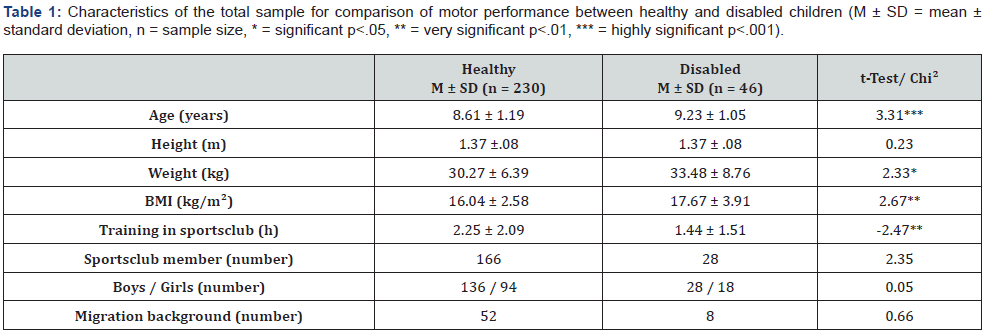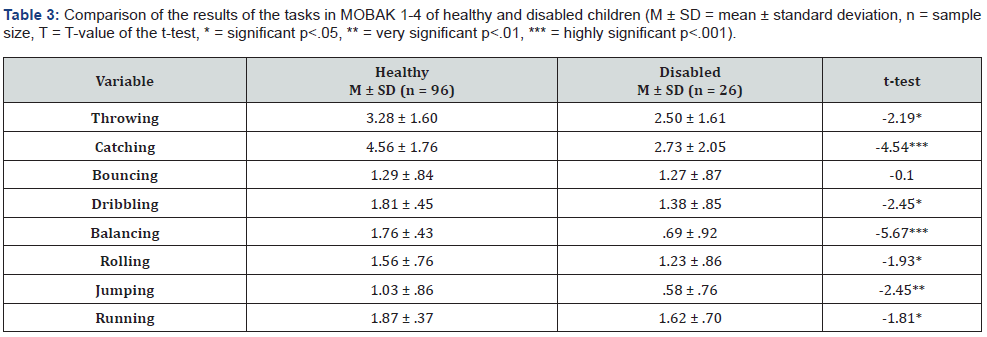Motor Performance of Healthy Children Compared to Children with Developmental Disabilities
Andrea Dincher*1,2
1Saarland University, Sports Sciences Institute, Germany
2RPTU Kaiserslautern-Landau, Campus Landau, Institute for Sports Sciences, Germany
Submission: April 07, 2023; Published: May 05, 2023
*Corresponding author: Andrea Dincher, Special Tasks Teacher, Saarland University, Germany, Email: andrea.dincher@uni-saarland.de
How to cite this article: Dincher A.Motor Performance of Healthy Children Compared to Children with Developmental Disabilities. Glob J Intellect Dev Disabil. 2023; 11(4): 555820. DOI:10.19080/GJIDD.2023.11.555820
Abstract
Purpose: Children with developmental disabilities show motor deficits. Previous studies are based only on norm values without a real control group. The present study aims to fill this gap.
Materials and methods: 276 children participated in the study. MOBAK 1-4 was conducted with one subsample and DMT 6-18 with the other. Raw or Z-scores of the individual test items and the overall percentile rank are evaluated. An ANOVA was calculated for group comparison.
Results: There is a significant difference in percentile rank between healthy and disabled children and between athletes and non-athletes. For the individual test tasks, significant differences between the groups are found with few exceptions.
Conclusions: The differences can be attributed to both developmental disability and club affiliation. Whether perhaps the concept of school (e.g., school in motion, sports school) can have an influence should be examined in further study, since over the school all children can be reached.
Keywords: Children; Motor Development; Developmental Coordination Disorder; Motor Abilities; Basic Motor Competencies
Introduction
Children with developmental disabilities show deficits in motor development compared to healthy peers. In this context, it was found several years ago that motor performance, measured by fundamental motor skills, is lower in children with autism, ADHD, learning disabilities, and Down syndrome [1-4] compared to healthy children. However, in these studies, the population studied in each case was compared with existing normal values or the disorders were compared with each other. In some cases, there was no healthy control group, and the factor of whether a child participates in a sports club was also not recorded. One study [5] was able to show here, for example, that children with a developmental disorder whose parents had a positive parental behavior one standard deviation higher than the average showed a statistically significant linear increase in the standard values for motor skills with age. Thus, it can be assumed that the children of these parents may be more likely to be enrolled in a sports club than the children of parents who had lower scores.
Therefore, the aim of the study is to determine differences in motor skills between children with and without developmental disabilities and whether sports club membership has an influence on this.
Materials and Methods
Sample of persons
A total of 276 children (164 boys and 112 girls) from four randomized selected German primary schools, participated in the study. Table 1 below provides a comparative overview of the characteristics of the total sample (Table 1).
There are significant differences between healthy and disabled children with regard to age, weight, BMI and sports lessons in the club.
In total, nine children suffer from ADHD, five others have two additional comorbidities (social disorder, dyslexia). Four children have a social conspicuity, two children asthma. Other conditions present in the sample include fetal alcohol syndrome, Prader-Willi syndrome, general developmental delay, cerebral palsy, muscular dystrophy, and others.

Variable sample
a) DMT 6-18: German motor test for children and adolescents aged six to 18. The test is based on the concept of motor abilities and consists of the tasks 20-meter sprint (speed), side-to-side jumping and balancing (coordination), stand & reach (flexibility), sit-ups, push-ups, and standing long jump (strength), and 6-minute run (endurance). The raw scores are converted to age- and sex-normalized Z-scores so that the scores from all tasks can be combined into an overall Z-score. Here, a Z-score of < 91.67 is rated as strongly below average, a score between 93 and 97.5 as below average, between 98 and 102.5 as average, between 103 and 108.33 as above average, and a score > 108.33 as strongly above average [6]. The Z-scores of the individual tasks, the total Z-score and the total percentile rank are evaluated.
b) MOBAK 1-4: Basic motor competencies for children in grades 1 to 4. The test consists of the tasks throwing, catching, bouncing, dribbling (moving objects) and rolling, balancing, jumping, running (moving oneself). One point is awarded per valid attempt (max. two per task) with the exception of throwing and catching. Here the raw scores from six attempts are converted into points (max. two per task). All point values are added up to a total score. In addition, an age- and gender-normalized percentile rank can be determined using this score [7]. The scores of the individual tasks, the total score, and the total percentile rank are evaluated.
Study flow
After consent from the regional ministry of education and ethics committee, four schools were randomly selected. After consent from the schools‘ heads and the children’s parents, dates for the tests were arranged. These all took place during school hours (8 a.m. to 12:30 p.m.) in the gymnasium of the respective school. The tests were conducted by four people (three students of sports science and the author). Four children were assigned to each tester. The test tasks were then performed in station mode. Approximately 30 to 40 minutes were required per such test run.
Statistics
Mean values and standard deviations of the results of the individual test tasks (Z-scores for DMT 6-18 or point values for MOBAK 1-4) of the healthy and sick children are presented and compared using a t-test. So that the different test results can also be compared with each other, the overall percentile rank is used for this purpose. The statistical program SPSS version 29 is used for this purpose. The significance level is set at p < .05.
Results
The following Table 2 gives a comparative overview of the results of the healthy and disabled children in DMT 6-18 and MOBAK 1-4 in the form of the total percentile rank.
There is a highly significant difference between the groups. The healthy children achieve an overall rank about 25 percentage points higher than the disabled children. Table 3 below shows the results of the tasks in MOBAK 1-4. With the exception of bouncing, all tasks in MOBAK 1-4 show significant differences between healthy and disabled children. Table 4 below shows the results of the tasks in DMT 6-18.
With the exception of the sprint, stand & reach, and standing long jump tasks, significant differences are found between healthy and disabled children.
Discussion
The aim of the study was to find out differences in motor performance between healthy children and children with developmental disorders.



In the first analysis of the total percentile of the complete sample, it is very clear that the healthy children are about 20 percentage points above the 50th percentile, while the children with a developmental disability are just below the 50th percentile. It can be clearly seen that the children who train in a sports club achieve a higher percentile rank. The healthy children who are not members of the club achieve a similar percentile rank as the sick children who train in the club. The healthy children who train in the club perform best; the disabled children who are not in the club perform worst.
If we now look at the results in the individual tests or the individual test items, we see the following:
In MOBAK 1-4, the healthy children managed at least one valid attempt on average in all tasks except one, i.e., scored at least one point, whereby in throwing and catching, three to four successful attempts correspond to one point, and five to six successful attempts correspond to two points [7]. The children with developmental disabilities only succeed in bouncing, dribbling, rolling, and running. This clearly shows that the children with developmental disabilities do not have the necessary basic competencies to a sufficient degree to participate in movement, play, and sports [8]. The healthy children are in the above-average range for the tasks of the DMT 6-18 with the exception of the 6-minute run (just below average), the jumping to and from the side and the push-ups are to be rated as strongly above average according to Bös et al. [6]. The children with developmental disabilities perform below average in balancing and strongly below average in the 6-minute run.
Overall, all children in the sample show below-average endurance performance.
The differences between the healthy and disabled children are possibly due to the limitations of the developmental disorder, but on the other hand also due to the significant differences between the studied groups in age, weight, BMI and sports participation. The children with developmental disability are heavier and have higher BMI. This may be due to the fact that children with disabilities have poorer sedentary behavior and lower activity levels compared to healthy peers [9,10]. They also participate in about one hour less of club sports per week than the healthy individuals. This could also be due to socialization by parents or their behavior [5]. While mastery of some fundamental movement skills (e.g., walking, running) appears to develop naturally, other skills (e.g., the overhand throw, the push-off) are more likely to be learned through increased instruction, skill-specific feedback, and practice [11]. Children who do not receive adequate instruction or practice opportunities in these areas are likely to experience developmental delays in the acquisition of fundamental movement skills.
Acknowledgment
This work was financially supported by the regional German Sports Teacher Association.
Summary and Prospects
The present study was designed to reveal differences in motor performance between healthy and disabled children. Significant differences were found throughout in favor of healthy children.
This can be explained not only by the developmental disorder itself, but also by support measures in the form of sports activities in clubs. Further studies should examine which programs in schools, such as “school in motion” or “sports school” or “sport promotion lessons” have an effect on the motor performance of the children. Support measures that are carried out within the instructional time at school, in addition to the mandatory physical education classes, would reach all children at this point. Thus, not only the disabled children would get the opportunity to reduce their deficits.
References
- Pan CY, Tsai CL, Chu CH (2009) Fundamental Movement Skills in Children Diagnosed with Autism Spectrum Disorders and Attention Deficit Hyperactivity Disorder. J Aut Dev 39(12): 1694-1705.
- Beyer R (1999) Motor Proficiency of Boys with Attention Deficit Hyperactivity Disorder and Boys with Learning Disabilities. Adapt Phys Act Quart 16(4): 403-414.
- Westendorp M, Hartman E, Houwen S, Smith J, Visscher C (2011) The relationship between gross motor skills and academic achievement in children with learning disabilities. Res Dev Dis 32(6): 2773-2779.
- Volman MJM, Visser JJW, LensveltMulders GJLM (2007) Functional status in 5 to 7-year-old children with Down syndrome in relation to motor ability and performance mental ability. Disabil Rehabil 29(1): 25-31.
- Ku B, Stinson JD, MacDonald M (2021) Parental Behavior Influences on Motor Skills Development in Young Children with Developmental Disabilities: A Two-Year Longitudinal Study. Child Psychiatry Hum Dev.
- Bös K, Schlenker L, Büsch D, et al. Deutscher Motorik-Test 6-18 (DMT 6-18) [German motor test 6-18]. Hamburg: Czwalina.
- Herrmann C (2018) MOBAK 1-4. Test zur Erfassung Motorischer Basiskompetenzen für die Klassen 1-4 [Test for capturing basic motor competencies for grades 1-4]. Göttingen: Hogrefe.
- Strotmeyer A, Kehne M, Herrmann C (2020) Motorische Basiskompetenzen [Basic motor competencies]. Ger J Ex Spo Res 50: 82-91.
- Altman B, Bernstein A (2008) Disability and health in the United States, 2001-2005. Hyattsville: National Center for Health Statistics.
- Rimmer JH, Rowland JL, Yamaki K (2007) Obesity and Secondary Conditions in Adolescents with Disabilities: Addressing the Needs of an Underserved Population. J Ado Health 41(3): 224-229.
- Lubans DR, Morgan PJ, Cliff DP, Barnett LM, Okely AD (2010) Fundamental movement skills in children and adolescents: review of associated health benefits. Sports Med 40(12): 1019-1035.






























